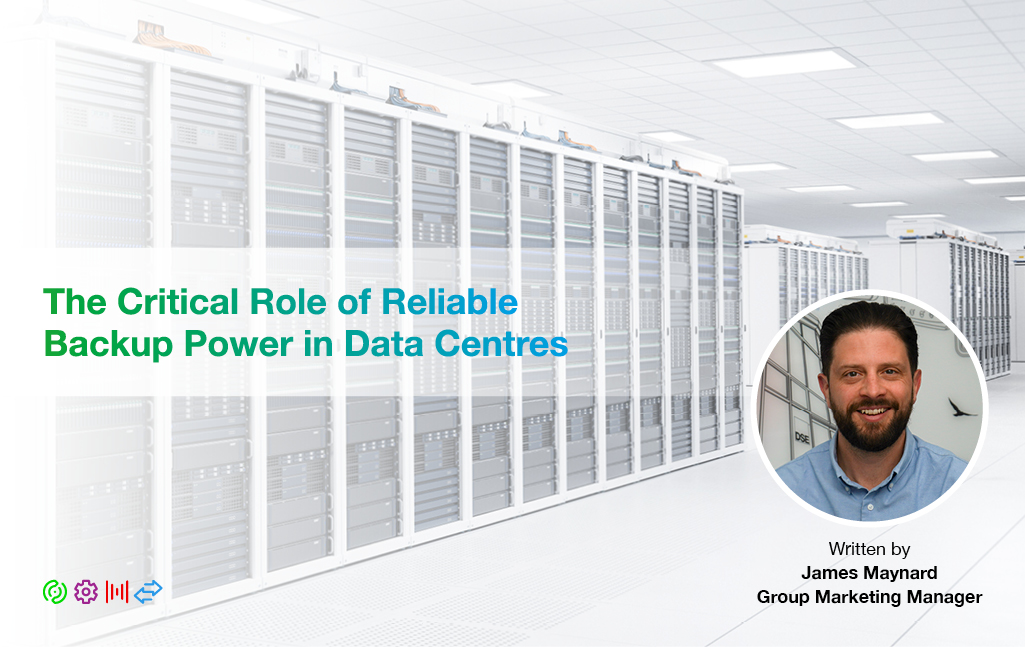
The Critical Role of Reliable Backup Power in Data Centres
James Maynard, Group Marketing Manager, DSE, looks at why reliable back-up power in data centre environments is an essential requirement in today’s digitally connected world.
In today’s rapidly evolving digital landscape, data centres have become the backbone of global connectivity, supporting everything from cloud services and AI computing to financial transactions and real-time communications. With this growing dependence on digital infrastructure, the need for reliable, integrated backup power systems has never been more important. When milliseconds of downtime can cause serious disruption and data loss, maintaining a seamless and resilient power supply is a non-negotiable priority.
At the heart of every high-performing data centre lies a carefully designed power infrastructure built around redundancy, responsiveness, and real-time control. While utility power remains the primary energy source, backup systems such as generators, uninterruptible power supplies (UPS), and automatic transfer switches (ATS) play a crucial role in ensuring continuity during faults, outages or voltage fluctuations.
Redundancy and Resilience Built-In
Reliability begins with redundancy. In a mission-critical environment like a data centre, any single point of failure must be eliminated. This is typically achieved through configurations such as N+1 or 2N power architectures, where backup capacity matches or exceeds load demand, ensuring there's always an alternative source ready to take over. This guarantees that power delivery remains consistent, even during maintenance or equipment failure.
But having backup power is not enough. It must be intelligently integrated into the wider infrastructure to respond quickly and efficiently. This is where advanced paralleling controllers and power management systems come into play. At DSE, our intelligent controllers and monitoring solutions enable synchronised operation between multiple generators, seamless load sharing, and real-time decision making - all of which contribute to uninterrupted power supply and improved system longevity.
Speed is Everything
The speed at which power can be transferred from the utility supply to the backup source is critical. Whether it’s a momentary brownout or a full-scale outage, delay in switching can result in dropped connections, data corruption, or hardware failures. Modern ATS systems equipped with high-speed controllers can detect instability and complete the switchover in a matter of seconds - often without noticeable impact to end users or equipment.
Advanced features such as closed transition switching, allow the transfer of load without dropping power entirely — ideal for sensitive data centre loads where even momentary interruption is unacceptable.
Visibility and Control from Anywhere
Equally important is the ability to monitor and control backup systems remotely. With decentralised teams and 24/7 operation, data centre managers always need full visibility of power assets. Remote monitoring platforms provide real-time insights into generator status, fuel levels, fault alerts, and performance metrics — helping teams act quickly, reduce downtime, and plan maintenance proactively.
Integration with building management systems (BMS), data centre infrastructure management (DCIM) tools, and enterprise-level software further streamlines operations and enables joined-up decision making.
Planning for Growth and Efficiency
As data volumes continue to rise, the energy demands placed on data centres grow in parallel. Scalability, therefore, is a key consideration. Backup power systems must be able to evolve with the facility. Modular generator systems, flexible controller architecture, and scalable monitoring platforms ensure that resilience is never compromised as capacity expands.
At the same time, cost-efficiency must remain front of mind. Intelligent load management, remote diagnostics, and automated test cycles all contribute to lower running costs, longer equipment life, and improved sustainability.
Conclusion
Reliable, integrated backup power is not just a safety net for data centres - it’s a foundational pillar of operational continuity. With the right combination of robust hardware, intelligent controls, and comprehensive monitoring, facilities can ensure uptime, protect data integrity, and support uninterrupted service in an increasingly digital world.
At DSE, we’re proud to help data centres across the globe achieve this with cutting-edge UK manufactured control solutions built for performance, precision, and peace of mind. To learn more click here
